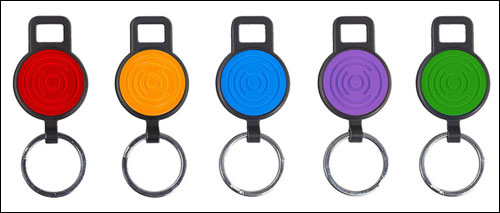Chicago-based startup Ocho has developed a device that acts as a Near Field Communication (NFC)-enabled tray, to help users track keys, wallets, cell phones and other items in their home or office. The company launched the technology this week on Kickstarter, with long-term plans to develop partnerships with large retailers that could sell the product at their stores.
The Ocho device (named for the Spanish word for the number 8—the developers’ initial number of potential use cases), comes in two sizes (the Pad and the Mini) and has a built-in NFC reader, as well as a Wi-Fi transmitter. When an RFID-tagged item or an NFC-enabled phone or tablet is placed on the Pad or Mini, the device captures that item’s unique ID number and forwards that data to a cloud-based server via the user’s Wi-Fi router. This prompts other actions, such as sending a text message or issuing a visual or audible alert to remind him to plug in the charger, or sending a text message to a family member letting her know who has arrived home, based on the tag ID interrogated.
The solution was developed by Kenneth Mages and Ocho’s CEO, Don Leung. The two entrepreneurs (Mages in Chicago, and Leung in Hong Kong) have spent the past several years collaborating on researching and developing the solution. Mages has been developing payment solutions for approximately 15 years, he says, and was the founder and CTO of NFC Data, for which he developed an NFC-based wallet or key fob. Because the deployment of NFC payment infrastructure (such as point-of-sale NFC readers, as well as NFC readers in phones) has been sluggish, he says, he and Leung began working on other solutions during the past two years, based on the NFC hardware they had already developed. The duo began investigating ways in which the technology could provide the greatest benefit to consumers. “This is hardware we’re really proud of,” he states, “and we wanted to put it in a package that has function.”
NFC technology is commonly developed around the concept of prompting a response to an action, Mages notes, based on an NFC read or “touch,” though he and Leung were interested in offering a solution that would activate a response if a particular tag was not read. For example, he says, the Ocho system, with data managed on a cloud-based server, can be programmed to identify whether a set of keys was not returned to the Pad when it should have been, or if a phone was not plugged into the device’s built-in USB charger. It can also use the presence of a tag to create a response. If a user forgot to take out the garbage, for instance, he could input a message into the system that would be sent to his daughter only after she placed her own house keys on the Pad (indicating she had returned home), asking her to take out the garbage for him.
“We hunkered down in September to make this product,” Mages says, and launched the Kickstarter page this week to begin accepting sales. The software was developed by Anthony Garvan, who is now the company’s lead software developer.
The Ocho Pad, which measures 11.8 inches by 8.18 inches, is large enough to hold a wallet, a phone, a tablet, a laptop or keys, while the Ocho Mini, which measures 8 inches by 5.2 inches, is intended primarily for keys. Both versions, manufactured by Ocho, include an NFC reader (Mages says the company is vendor-neutral and will work with multiple makes and models of NFC readers and tags), and an infrared (IR) sensor to detect whether something is on the tray—for individuals who prefer not to use NFC technology—along with a USB connection for charging phones or other devices. It also has Wi-Fi technology that allows the Pad and Mini to communicate directly with Ocho’s server, where the user’s account is stored and instructions related to read data prompt specific actions.
Upon purchasing the Ocho Pad or Mini, an individual receives five Ocho tags containing built-in standard Mifare-compatible inlays made with AMS RFID chips in a variety of form factors, such as a card (which could be placed in a wallet), sticker or key fob. The Pad or Mini plugs into any power outlet via a USB power adapter.
To set up the Ocho Pad, a user taps a tag against the device, which has a liquid crystal display (LCD) interactive screen that then displays an Internet-based application asking the user to assign a name and task for that tag—such as sending a text message to his phone when his child places her keys on the Pad, or sending a text at 10 PM if something, such as a wallet or keys, has not been detected as being placed on the device.

With the Ocho Pad system in place, Mages says he expects users will be better able to manage the way they spend their time, and to reduce the kinds of inconveniences that result from losing keys, forgetting a task or failing to get a message to a family member at the proper time. Some companies have also shown interest in the product, he notes, suggesting that it could be used, for instance, to track employees’ company-owned devices, such as keys, laptops or tablets, by providing each worker with a Pad into which he or she could deposit such objects while in the office. If something was not placed in the Pad when expected, management could then receive a message.
Buyers can pre-order the devices on Kickstarter, at a price of $68 for the Ocho Pad and $38 for the Ocho Mini. After the initial release period, the prices are expected to rise to $88 and $58, respectively. According to Mages, there will be no charge for server access.
Ocho now hopes to launch discussions with companies, such as large retailers that could sell the product at their stores.



